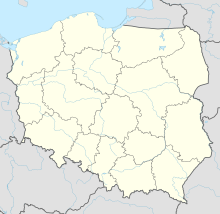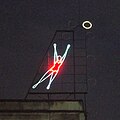Constitution Square, Warsaw
 The Constitution Square in 2022, as seen from the south. | |
| Location | Downtown, Warsaw, Poland |
|---|---|
| Coordinates | 52°13′20″N 21°00′58.3″E / 52.22222°N 21.016194°E |
| North | Marszałkowska Street |
| East |
|
| South |
|
| West |
|
| Construction | |
| Completion | 22 July 1952 |
The Constitution Square[a] is an urban square, and a road intersection, in Warsaw, Poland, within the Downtown district. It is placed at the intersection Koszykowa, Marszałkowska, Piękna, Śniadeckich, and Waryńskiego Streets. It is surrounded by the socialist realist multifamily residential buildings of the Marshal Residential District. The square was opened in 1952.
Name
[edit]The Constitution Square was named on 19 July 1952, after the Constitution of the Polish People's Republic, which was ratified a few days later on 22 July, on the same day that the square was opened.[1][2]
In 1999 a group headed by Radosław Sikorski, Deputy Ministrer of Foreign Affairs, launched a campaign to rename the square after Ronald Reagan, President of the United States from 1981 to 1989, as part of the decommunization efforts. It was unsuccessful, and the square remains the one of the last places in the city, with name linked to the communist period.[3]
In 2004, a small southwestern section of the square in the southwest, at the intersection with Waryńskiego Street, was named the Pakulski Brothers Alley (Polish: Zaułek Braci Pakulskich). The name comes from theee brothers, Adam, Jan, and Wacław Pakulski, who owned chain of grocery stores Pakulski Brothers, with one of them formerly placed in a tenement at 57 Marszałkowska Street, in what is niw the centre of the square.[4][5]
History
[edit]
The Constitution Square was formed in 1952, as central part of a then-constructed housing estate of Marshal Residential District.[6]
It was constructed on the axis of Marszałkowska Street, in place of the compact street grit with tenements, most of whom were destroyed during the Second World War. During the construction, all surviving buildings were also deconstructed. The street layout was also significantly altered, including moving Koszykowa and Piękna Streets, and building new Waryńskiego Street.[6][7][8]
Around the square were constructed six- and seven-storey multifamily residential buildings, designed in socialist realist style.[6] At the corner of Marszałkowska and Waryńskiego Streets was built the MDM Hotel, which became the first hotel to be opened in Warsaw after the Second World War.[6][9] In parallel to it, at the square were places three large candelabra pillars.[6] At the ground floors of the buildings around the square were opened stores and services.[10]

Its centre was turned into a large car park.[6] Originally the square was envisioned to feature a large fountain at its centre, and to be a final destination of the annual International Workers' Day manifestation marches.[11][12]
The Constitution Square was ceremonially opened, together with the entire Marshal Residential District, on 22 July 1952. The same day marked the ratification of the Constitution of the Polish People's Republic, that is the square's namesake.[1]
In 1989, in the coffee Niespodzianka in 6 Constitution Square building, was set up the headquarters of the Solidarity Citizens' Committee of Warsaw, which took part in the 1989 Polish parliamentary election. In 2019, there was unveiled a plaque commorating it.[13][14]
In 1980s, it was planed to construct there the Plac Konstytucji station of the M1 line of the Warsaw Metro underground rapid transit system. Its preliminary construction begun in 1986, before being halted in 1989 due to budgetary restrictions.[15][16] The city announced plans to resume the project in 2019, and in 2022 was presented its design.[16][17] Currently, the preparatory work is in progress ahead of the construction.[18]
Characteristics
[edit]The Constitution Square is placed on the axis of Marszałkowska Street, and forms an intersection of Koszykowa, Marszałkowska, Piękna, Śniadeckich, and Waryńskiego Street. Allong the square are also place the tram tracks.[6][19]
Its central section forms a car park, surrounded by the road intersection, while the outlying sections form a pedestrian area.[6][8][20]
The southwestern part, next to the intersection with Waryńskiego Street, is known as the Pakulski Brothers Alley (Polish: Zaułek Braci Pakulskich).[21]
The square is surrounded by six- and seven-storey multifamily residential buildings of the Marshal Residential District, designed in socialist realist. This includes the MDM Hotel at the intersection Marszałkowska and Waryńskiego Streets. In parallel to it, at the square are placed three large candelabra pillars.[6] At the ground floors of the buildings around the square were opened stores and services.[10]
Currently, it is planed there the Plac Konstytucji station of the M1 line of the Warsaw Metro underground rapid transit system.[16][17]
Gallery
[edit]-
MDM Hotel at 1 Constitution Square in 2021.
-
One of the three large candelabra pillars.
-
Valleyball Player, a neon installation from the 1950s, at the roof of 5 Constitution Square building.
Notes
[edit]- ^ Polish: Plac Konstytucji, [plat͡s kɔnstɨˈtut͡sji]
References
[edit]- ^ a b Karol Małcużyński: Szkice warszawskie. Warsaw: Książka i Wiedza, 1955, p. 157. (in Polish)
- ^ "Kronika wydarzeń w Warszawie 1945−1958", Warszawskie Kalendarz Ilustrowany 1959. Warsaw: Wydawnictwo Tygodnika Ilustrowanego Stolica, 1958, p. 66. (in Polish)
- ^ "Europe: Reagan touted for Warsaw honour". news.bbc.co.uk. 5 July 1999.
- ^ "Zaułek Braci Pakulskich". srodmiescie.um.warszawa.pl (in Polish).
- ^ "Uchwała Nr 88/17/2004 Rady Dzielnicy Śródmieście Miasta Stołecznego Warszawy z dnia 23 kwietnia 2004 r". bip.warszawa.pl (in Polish). 23 April 2004.
- ^ a b c d e f g h i Eugeniusz Szwankowski: Ulice i place Warszawy Warsaw: Państwowe Wydawnictwo Naukowe, 1970, p. 79–80. (in Polish)
- ^ Rafał Bielski, Jakub Jastrzębski: Utracone miasto. Warszawa wczoraj i dziś. Warsaw: Skarpa Warszawska, 2016, p. 102. ISBN 978-83-63842-27-7. (in Polish)
- ^ a b Józef Sigalin: Warszawa 1944–1980. Z archiwum architekta, vol. 2, Warsaw: PIW, 1986, p. 237–288. ISBN 83-06-01187-2. (in Polish)
- ^ Zenon Błądek: Dzieje krajowego hotelarstwa od zajazdu do współczesności: fakty, obiekty, ludzie. Poznań–Warsaw: Palladium Architekci, 2003, p. 32. ISBN 83-89284-02-2. (in Polish)
- ^ a b Tadeusz Podgórski: Zwiedzamy Warszawę. Warsaw: Sport i Turystyka, 1956, p. 182–184. (in Polish)
- ^ Zygmunt Stępiński: Gawędy warszawskiego architekta. Warsaw: 1984, p. 88. ISBN 83-03-00447-6. (in Polish)
- ^ Dobiesław Jędrzejczyk: Geografia humanistyczna miasta. Warsaw: 2004, p. 298. ISBN 83-88938-77-0. (in Polish)
- ^ "Odsłonięcie tablicy pod dawną kawiarnią 'Niespodzianka'". um.warszawa.pl (in Polish). 30 May 2019.
- ^ Wojciech Karpieszuk (29 May 2019). "'Tu była Niespodzianka'. Opozycjoniści z czasów PRL-u odsłonili tablicę pamiątkową przed 30. rocznicą wyborów w 1989 r." warszawa.wyborcza.pl (in Polish).
- ^ Krystyna Krzyżakowa: "Życie codzienne Warszawy dzisiejszej", Kalendarz Warszawski '88. Warsaw: Krajowa Agencja Wydawnicza, 1987, p. 197. ISBN 83-03-01684-9. (in Polish)
- ^ a b c "Stacje Plac Konstytucji i Muranów". metro.waw.pl (in Polish).
- ^ a b Witold Urbanowicz (5 December 2022). "Metro: Główne założenia dla stacji Plac Konstytucji i Muranów gotowe [wizualizacje]". transport-publiczny.pl (in Polish).
- ^ Kamil Jabłczyński (26 March 2024). "Co ze stacjami Plac Konstytucji i Muranów na pierwszej linii metra? Toczą się prace. Czy powstaną przed remontem średnicy?". warszawa.naszemiasto.pl (in Polish).
- ^ "Plac Konstytucji". srodmiescie.um.warszawa.pl (in Polish).
- ^ Krzysztof Mordyński: "Plac Konstytucji w Warszawie – eksperyment 'wielkomiejskiego' socrealizmu", Spotkania z Zabytkami, no. 2. 2008, p. 3–7. (in Polish)
- ^ "Zaułek Braci Pakulskich". srodmiescie.um.warszawa.pl (in Polish).
External links
[edit] Media related to Constitution Square at Wikimedia Commons
Media related to Constitution Square at Wikimedia Commons




